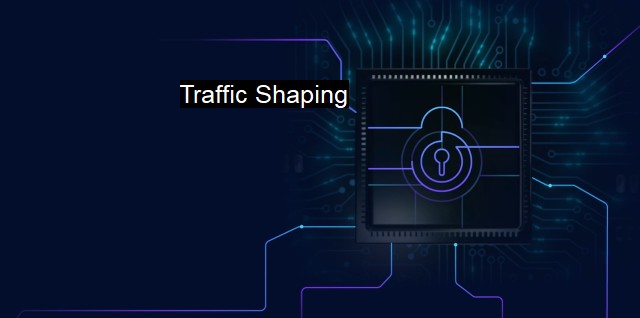What is Traffic Shaping?
The Importance of Traffic Shaping in Optimizing Network Performance and Cybersecurity
Traffic shaping, also known as packet shaping, is a critical concept in the realm of cybersecurity and antivirus. It refers to the manipulation of network traffic to optimize or guarantee the performance, lower latency, improved bandwidth usage, and prioritized, reliable communication. Internet Service Providers (ISPs) and network administrators widely use it. In today’s world, where traffic rates are immensely high, understanding traffic shaping is essential to ensure swift and secure data transfers.Traffic shaping is fundamentally about controlling the amount and rate of data that's transmitted over a network. The process of traffic shaping involves setting priorities for specific types of data, ensuring critical data packets get priority over non-critical ones, which could either be delayed or temporarily hindered to prevent network congestion.
The implementation of traffic shaping requires algorithms, often integrated into a specially formulated bandwidth management tool, that base their calculations on certain network parameters, primarily data packet size, the priority of the particular packet, and the overall usage of network bandwidth. With these measures, traffic shaping helps allocate resources in a manner that ensures maximum loading speed and reliability of a system.
Particularly in systems protected by antivirus software, traffic shaping plays a pivotal role by buffering certain non-essential data transmissions during periods of high traffic. It prevents the sudden overflow of data to protect the system's performance and integrity.
Subsequently, it can aid the early detection of potential threats in an overloaded system before any real damage ensues by flagging abnormal traffic patterns or elements that manage to consume network resources excessively. These might signify cyberattacks, like Denial of Service (DoS), which overwhelm the network or system with an avalanche of traffic to paralyze the usual functions.
Traffic shaping can provide contextual visibility into encrypted web traffic without necessarily hindering the SSL connection. The latter becomes useful to specifically identify whether the traffic exchanged by a user is authentic or malevolent.
Upon detection of a flaw in the network flow caused by a virus or any other malicious actor, traffic shaping algorithms can adjust the system settings, isolating and denying such elements access to take harmful actions swiftly. This aspect serves not just to react to immediate threats, but also acts proactively to counter possible future attacks.
Also, traffic shaping prevents network clogs by ensuring smooth function during antivirus downloads or upgrades by preferentially permitting these procedures to gain efficient bandwidth usage. The delay of nonessential data can help make bandwidth quotas effectively used in these situations, facilitating fast, unhindered system updates and consequently, a secure system.
VPNs, “Traffic Shapers,” sophisticated network tools popular within cybersecurity frameworks also utilize the technique. They work to control network traffic, enhance performance, firewall strength, employ protocols that limit data transfer to a specified transmission rate, or delay packets to produce an apparent orderly data flow and avoid clogging.
Traffic shaping presents three common techniques that various entities use: Leaky Bucket, Token Bucket, and Traffic Policing and Shaping. Each of these techniques highlights different aspects, such as network performance regulation, packet pace adjustment, and a holistic regulation approach for incoming and outgoing traffic, respectively, thereby preventing any abnormal network behaviors efficiently.
In this digital era, traffic shaping acts as a catalyst in improving network efficiency while bolstering cybersecurity mechanisms. Its role in managing network traffic, enabling resource optimization, preventing unauthorized network access, and enhancing system performance cannot be understated. The prioritization provided by traffic shaping ensures core network services remain accessible even when under considerable system demands, providing an important line of defense in a multilayered cybersecurity approach.

Traffic Shaping FAQs
What is traffic shaping and how does it relate to cybersecurity?
Traffic shaping is the practice of controlling the flow of network traffic to prioritize certain types of traffic over others. This is important in cybersecurity because it allows network administrators to limit or block traffic that may pose a security risk, such as traffic that comes from malicious sources or that contains viruses or malware.What are the benefits of using traffic shaping in antivirus software?
Traffic shaping helps antivirus software better detect and respond to threats by allowing the software to monitor and control the flow of traffic in real-time. This means that the antivirus can quickly identify and block traffic that may be harmful, reducing the likelihood of a successful cyberattack.Can traffic shaping help prevent DDoS attacks?
Yes, traffic shaping can be an effective way to prevent Distributed Denial of Service (DDoS) attacks, which are commonly used to overwhelm websites or other online services. By prioritizing legitimate traffic over malicious traffic, traffic shaping can help ensure that websites and services continue to function even in the face of a DDoS attack.What are some common techniques used in traffic shaping for cybersecurity purposes?
Some common techniques used in traffic shaping for cybersecurity purposes include bandwidth limiting, Quality of Service (QoS) shaping, and protocol-based shaping. These techniques allow network administrators to prioritize certain types of traffic, limit the amount of bandwidth that can be used by certain types of traffic, and block or limit traffic based on specific protocols or applications.| | A | | | B | | | C | | | D | | | E | | | F | | | G | | | H | | | I | | | J | | | K | | | L | | | M | |
| | N | | | O | | | P | | | Q | | | R | | | S | | | T | | | U | | | V | | | W | | | X | | | Y | | | Z | |
| | 1 | | | 2 | | | 3 | | | 4 | | | 7 | | | 8 | | |||||||